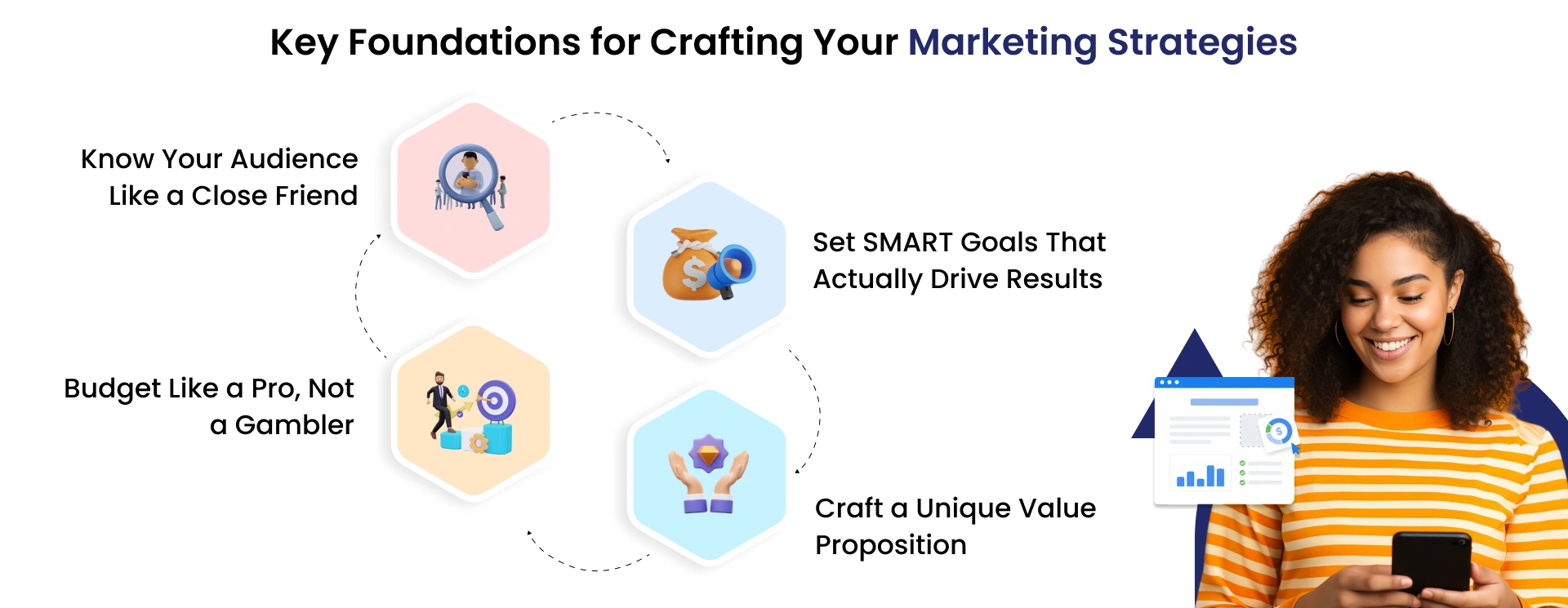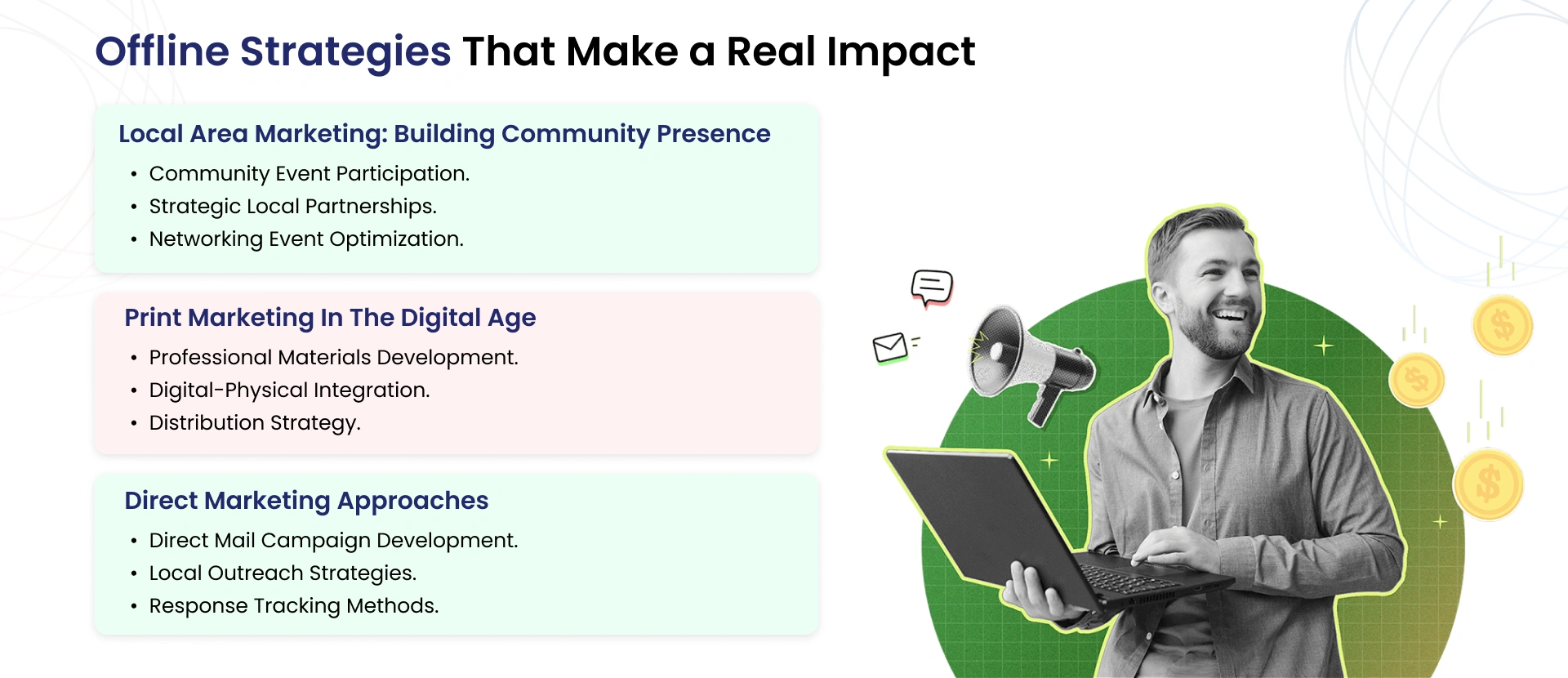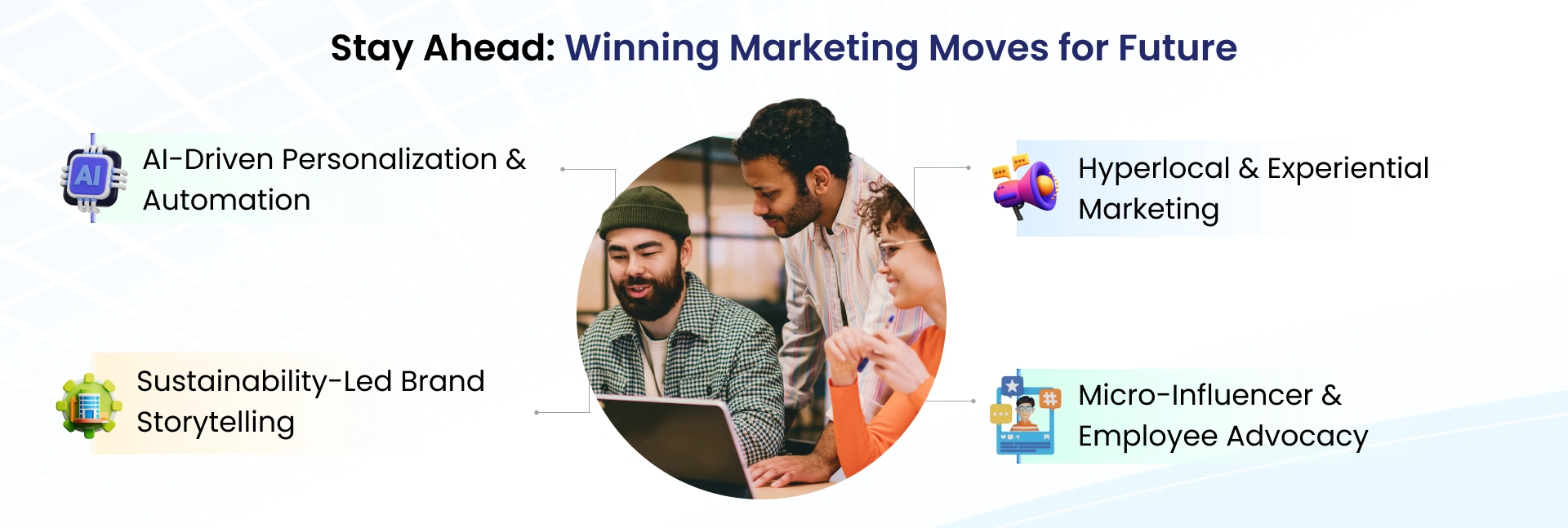
Small business owners today encounter a complex and crowded marketing environment. In addition to managing numerous other responsibilities, small business owners must compete with larger brands on a limited budget and ensure that every marketing decision is impactful. It's no surprise that 73% of small businesses are still unsure whether their marketing efforts will produce real results, even though nearly half of these companies intend to increase their marketing budget in future. There is a lot of pressure to choose the right channels, measure success, and stand out from the competition because nearly half of the owners handle marketing in-house and only allocate 5-10% of revenue.
Your success is based on the quality of your foundational work, not how much you spend. Starting with identifying your ideal clients, creating SMART goals, and finding creative ways to stretch your budget, this guide will show you how to shift from a disorganized to a strategic approach. This guide will equip you with proven offline and online strategies, along with practical methods for transforming marketing confusion into clarity. To achieve your company's goals, we must first understand what motivates your customers.
Marketing success is not accidental; it is the result of fundamental principles that guide every decision. A well-structured small business marketing plan is built on these principles. The right foundation supports immediate campaigns and ensures long-term growth. Let's build the foundation piece by piece. If you’re wondering how to create a marketing plan for a small business, it all starts here.

Every small business marketing plan begins with a clear understanding of your audience, and understanding your audience goes beyond basic demographics. Your ideal customers are complex individuals with distinct desires, challenges, and motivations that influence their purchasing decisions. Creating detailed customer personas turns abstract market segments into realistic representations of the people you want to serve. Move beyond age, income, and location to investigate psychological aspects such as values, fears, aspirations, and daily routines. What keeps them awake at night? How do they prefer to consume information? What previous solutions left them disappointed?
Effective market research provides data-driven insights into these personas. Use both quantitative and qualitative methods: send surveys to existing customers, conduct one-on-one interviews with prospects, and analyze engagement patterns across your digital channels. Industry reports provide useful context, revealing how your target audience's preferences change over time. Social listening tools capture unfiltered conversations about your industry, highlighting pain points that you might otherwise overlook.
Competitive analysis builds on this foundation by revealing market gaps and opportunities. Examine not only what your competitors offer but also how they present themselves and communicate with customers. Identify their strengths to learn what you're up against and their weaknesses to see where you can shine. Most importantly, look for underserved needs, problems that your competitors haven't yet addressed but that your company could solve exceptionally well.
Your marketing goals must evolve from vague aspirations to concrete objectives that guide daily decisions.

This precision clarifies what success looks like and establishes metrics for tracking progress along the way.
Aligning these objectives with your company's resources ensures practicality. When setting goals, keep your company's current stage of growth in mind as well as available capabilities. If you're managing marketing alongside other responsibilities, prioritize fewer high-impact goals to avoid overstretching yourself. Your marketing budget, which is typically 5-10% of revenue for small businesses, should help you set goals by prioritizing initiatives that have the greatest impact while remaining within your budget.
Realistic timelines take into account both market rhythms and operational capacity. Break down annual marketing goals into quarterly milestones that build momentum while allowing for flexibility. When setting deadlines, take into account seasonal fluctuations, industry trends, and your sales cycle. This thoughtful sequencing ensures that you prioritize the right activities at the right time, resulting in long-term progress toward your goals. This approach is central to any effective small business marketing plan.
Allocating your budget wisely is a foundational marketing tactic for small businesses. Begin by determining your overall marketing investment, which is typically 5-10% of revenue for established small businesses and potentially higher for growth-oriented startups. Distribute this budget across channels based on customer behavior and past performance data. Digital channels frequently account for the majority of the share, with social media campaigns receiving approximately 15%.
Spend evenly between proven performers and experimental initiatives. Allocate roughly 70% to core marketing activities that have produced results; these are your dependable growth engines. Set aside 20% for testing new approaches or messages that may reveal additional growth opportunities. Keep the remaining 10% as a flexible fund to respond to unexpected market changes or competitive challenges.
Tracking ROI necessitates establishing specific metrics for each marketing dollar spent. Monitor customer acquisition costs by channel and compare them to customer lifetime value to determine profitability. Set specific performance indicators for each initiative, such as digital campaign conversion rates, event attendance, and direct mail response rates.
Your unique value proposition (UVP) explains why customers should choose your company over competitors. This concept goes beyond simply standing out; it entails differentiating in ways that are meaningful to your target audience. Determine what truly distinguishes your company, whether it is proprietary technology, unique expertise, exceptional service, or a novel approach to problem solving.
Effective UVPs address customer problems in ways that competitors do not. Document how your products or services address specific issues that frustrate your ideal customers. What are the common challenges they face? How does your solution improve their experience or results? The most effective value propositions frequently include an unexpected benefit that surprises and delights potential customers, generating immediate interest and relevance.
Consistent messaging ensures that your unique selling point is communicated effectively across all customer touchpoints. Incorporate your value proposition into all aspects of your marketing, including website content, social media posts, email campaigns, sales materials, and customer service interactions. This consistency reinforces your unique positioning and keeps your message from becoming diluted. As market conditions and customer preferences change, regularly revisit your Unique Value Proposition (UVP) to ensure it remains distinctive and relevant. A strong value proposition is central to the best Marketing strategies for small businesses.
Marketing success depends on your digital presence in today's interconnected world. Digital channels are a core part of a modern small business marketing plan, as 52% of small businesses use social media as their primary growth channel.

Your website is your best sales tool, not just a brochure. In an age when 93% of purchases start with an online search, your site must be a compelling showroom and conversion engine.
User decision psychology underpins conversion-focused design. Use clear navigation to direct visitors to strategic calls to action. Your value proposition should be prominently displayed with testimonials or trust badges. In driving action, simplicity often wins.
Local SEO requires special attention for local businesses. Start by optimizing your Google Business Profile, which is often overlooked but essential for local visibility. Use location-specific keywords naturally in your content, focusing on terms that your community searches for. Create locally relevant content and network with local businesses for backlinks.
Mobile optimization is required when 60% of searches are from smartphones and tablets. Your site must be responsive to work on all devices. Use large buttons and clear menus to speed up touchscreen loading and navigation. Optimizing your website for mobile users is the best way to market a small business online.
Content marketing goes beyond blogging to create useful resources that establish your company as an expert. Content marketing remains one of the most effective marketing tactics for small businesses.
Content that builds authority must be planned and executed. Start by finding industry knowledge gaps that match your expertise. Create core content that covers essential topics, then add supporting content that delves deeper. Content calendars should balance current topics and evergreen resources.
Lead magnets boost email lists and demonstrate expertise. Create comprehensive guides, templates, checklists, or exclusive research to solve your target audience's problems. The key is providing genuine value that makes sharing contact information feel fair rather than transactional.
SEO and authentic value creation must be balanced. While keywords are relevant for visibility, good content that serves your audience will naturally include relevant terms. Focus on user intent over keyword density and comprehensive resources over shallow ones.
Successful social media marketing goes beyond sponsored campaigns. Social media should reflect your brand and build genuine relationships.
Know where your audience spends time, so choose a platform strategically. Determine the best channels by analyzing customer demographics and behavior. Focus on two or three platforms that match your audience and goals rather than spreading resources thinly across many.
Content strategies tailored to each platform recognize social culture. LinkedIn values professional insights, while Instagram values visual storytelling. TikTok requires creative short-form videos, while Facebook groups encourage community discussions. Adjust your messaging while maintaining brand voice in these contexts.
Authentic community engagement turns followers into advocates. Respond quickly to comments, ask thoughtful questions, and thank users. Remember that engagement is mutual; join industry discussions and support community projects beyond your promotion.
Email marketing has one of the highest ROIs and connects you to your audience outside algorithm-controlled platforms. Email campaigns are a classic marketing tactic for small businesses looking to nurture leads.
List building should attract quality subscribers through value-driven methods. Use strategic website forms, valuable content upgrades, exclusive webinars, and special promotions to encourage opt-ins. Remember that organic, permission-based growth generates more responsive contacts than purchased ones.
General broadcasts become personalized conversations through segmentation. Use demographics, purchase history, engagement, and interests to segment subscribers. Address segment-specific concerns with targeted campaigns. Simple segmentation increases open rates compared to universal approaches.
Automation allows mass personalized communication without manual intervention. Set up welcome series for new subscribers, abandoned cart reminders, and re-engagement campaigns for inactive contacts. Automation lets you send the right message to the right person at the right time.
With 40% of small businesses using search advertising, paid promotion is essential to digital strategy. Paid advertising is among the fastest Marketing strategies for small businesses to generate visibility.
Testing and scaling underpin advertising sustainability. Start small, creative campaigns targeting your most promising customer segments. A/B test elements to find winning combinations. After finding successful campaigns, gradually increase investment while monitoring performance.
Your platform choice should match your business goals and audience behavior. Search platforms attract high-intent prospects actively seeking solutions, while social platforms serve awareness and consideration. Before investing, compare each platform's targeting, ad formats, and industry competition.
Budget optimization requires strategic allocation and refinement. New campaign testing should include daily spending caps. Please allocate your campaign budget according to performance data rather than assumptions, directing more resources to high-converting channels and less to those that are underperforming.
While digital marketing dominates conversations today, offline strategies are still surprisingly effective, particularly for small businesses that serve local communities. These traditional approaches generate tangible brand experiences and personal connections that digital channels cannot match.

Local marketing success is based on becoming an integral part of your community's fabric. Your physical presence and active participation foster trust in ways that digital interactions cannot replicate. Local partnerships and event participation are proven marketing tactics for small businesses.
Active participation in community events distinguishes your company as a committed local stakeholder, rather than just another business. Sponsor local sports teams, take part in charity runs, or organize workshops at community centers. These activities increase your visibility while demonstrating your commitment to local well-being. Relationships formed at these events frequently lead to loyal customers who choose your business in part because of your community contributions.
Forming alliances with complementary local businesses generates significant marketing synergies. Identify businesses that cater to your audience but do not directly compete with your offerings. A coffee shop may collaborate with a local bookstore to host reading events, whereas a fitness studio may collaborate with a nutritionist to offer wellness workshops. These partnerships enable you to share marketing costs, broaden your reach, and develop unique value propositions that benefit both businesses and customers.
Approach networking with a focus on quality rather than quantity. Chamber of Commerce meetings, industry conferences, and local business associations all provide opportunities to build meaningful relationships. Prepare concise, compelling descriptions of your company's value proposition. Follow up with new contacts within 48 hours, and constantly investigate how to add value before asking for anything in return. Effective networking isn't about collecting business cards; it's about cultivating genuine relationships that promote long-term growth.
Physical marketing materials create tangible brand experiences that cut through the digital noise and leave a lasting impression. Print materials, when used strategically, remain valuable Marketing strategies for small businesses.
Invest in high-quality print materials that convey your brand's values and professionalism. Business cards remain essential for making first impressions, whereas brochures allow for more in-depth storytelling. Consider promotional products, such as branded items, that offer recipients practical value. Custom signage and window graphics turn your physical location into an active marketing tool that attracts attention and conveys important messages.
Strategic integration helps bridge the gap between printed and digital experiences. Incorporate QR codes into printed materials that lead to special landing pages or exclusive offers. Add NFC technology to business cards to enable instant digital contact sharing. To track engagement across channels, include custom URLs or personalized codes in your direct mail pieces. This integration ensures that your physical and digital touchpoints provide seamless customer journeys, maximizing their effectiveness.
Strategic distribution ensures that your printed materials reach the intended audience at the appropriate time. Distribute brochures and business cards to complementary local businesses through cross-promotional arrangements. Consider sending selective direct mail campaigns to specific neighborhoods. Distribute materials at community events, trade shows, and networking functions where your ideal customers are present. Monitor which distribution channels generate the most responses and adjust your strategy accordingly.
Direct marketing establishes one-on-one relationships with potential customers, breaking through the clutter of mass advertising. Direct mail is a time-tested marketing tactic for small businesses seeking tangible engagement.
Despite its digital prevalence, direct mail generates significantly higher response rates than email, 4.4% versus 0.12%. Create unique mailers with clear value propositions and compelling offers. Personalize materials whenever possible, using recipients' names and tailoring offers to their specific needs. Use high-quality materials and eye-catching designs to make your brand stand out in the mailbox.
Strategic door-to-door marketing can be effective for local service businesses if done correctly. Concentrate on neighborhoods that match your ideal customer profile, and prepare concise, useful presentations. Train representatives extensively on engagement techniques and proper follow-up protocols. This approach is especially effective for home services, local contractors, and community-oriented businesses.
Implement systems for measuring the effectiveness of direct marketing. For each campaign, create unique coupon codes, phone extensions, or landing pages. Track both immediate responses and delayed conversions, which may occur weeks after the initial contact. Analyze which messages, offers, and demographics get the most responses, and use this information to improve future campaigns.
Word-of-mouth remains the most trusted form of marketing, with personal recommendations having a greater influence on purchasing decisions than any other form of advertising. Adopting innovative marketing tactics for small businesses ensures you stay ahead of trends.
Create structured referral programs to encourage and reward customer advocacy. Offer incentives for both the referrer and the new customer, such as a discount, free service, or exclusive access. Consider tiered rewards for multiple referrals to encourage ongoing advocacy. Make participation simple by providing easily shareable referral links or codes that track who referred whom.
Create a systematic approach to collecting compelling customer stories. Reach out shortly after a positive experience, when enthusiasm is at its peak. For maximum impact, collect video testimonials that convey genuine emotion and foster trust. Consider offering small incentives to customers who are willing to share their experiences, while ensuring testimonials are genuine and credible.
Actively manage your online and offline reputation by encouraging satisfied customers to share their feedback. Create simple processes for leaving reviews, such as follow-up emails that include direct links to review websites. Respond quickly to all reviews, positive and negative, to demonstrate your commitment to customer satisfaction. Use feedback to gain valuable insights about how you can improve your products and services.
To stay ahead in small business marketing, you need to be open to new ideas and change based on what people want today. Adopting innovative Marketing strategies for small businesses ensures you remain competitive and relevant. These trends and strategies will determine the success or failure of businesses in future. We aim to make each strategy useful, user-friendly, and results-oriented.

Big brands are no longer the only ones who can use artificial intelligence. In the coming days, small businesses will use AI-powered tools to automate boring marketing tasks, make the customer experience more unique, and see how well their campaigns are doing right now. AI helps you work smarter and connect with your audience more deeply. For example, you can use chatbots to answer frequently asked questions (FAQs), predictive analytics to fine-tune ad targeting, or dynamic email recommendations based on browsing habits.
Customers want real, local experiences. With geofencing and hyperlocal marketing, you can send customers deals when they are nearby. Pop-up events and in-person demos bring your brand to life outside of screens. By hosting workshops or working with local artists on community events, you can build trust and make connections that will last. These strategies will attract people and spread via social media and word of mouth.
Customers today expect companies to have a moral stance. By using eco-friendly packaging, being open about your supply chains, or getting involved in the community, you can show that you care about the environment and build loyalty. Whether it's a new recycling program or a partnership with a nearby charity, be transparent about your journey. People are more likely to buy brands that stand for things they believe in.
Marketing through influencers is changing. Instead of going after famous people, small businesses are teaming up with micro-influencers, like local celebrities or people who make niche content, to get real, relatable endorsements. A growing trend is also employee advocacy. Putting your team in social media posts or letting them take over your Instagram Stories makes your brand more human and builds trust. When you share customer stories and testimonials in creative ways, they reach more people and give you more credibility.
By using these innovative marketing strategies, you'll not only stay on top of industry trends, but you'll also build stronger relationships with your customers, both online and off.
Small businesses that want to do well need to know what works and why in a marketing world that changes quickly. Continuous improvement and measurement aren't just for big businesses; they're essential for all businesses to grow in the long term.

First, figure out which metrics are really moving your business forward. Analytics for your website, like traffic, bounce rate, and conversion rate, show you how people use your online store. How well your brand connects with your audience can be seen by how many likes, shares, comments, and new followers you get. Not only is list size important for email campaigns, but open rates, click-throughs, and conversions are also. Finally, sales data and the lifetime value of a customer give the most accurate picture of marketing ROI.
Marketing isn't something you do once and forget about. The small businesses that do the best use every campaign as a chance to learn something new. You can see which words and images really connect with people by running A/B tests on your ads, landing pages, or emails. It's okay to make small changes every now and then. These small changes can add up to big gains over time. Look at your results often, enjoy the things that are working, and use feedback and data to improve your approach.

The key to effective marketing is to make strategic, intelligent decisions, whether you are enhancing your digital presence, establishing community connections, or experimenting with new strategies. Positioning your business for sustainable growth in a rapidly changing landscape necessitates comprehending your audience, establishing clear objectives, and incorporating both established and emerging strategies.
The team at JanBask Digital Design offers customized solutions and hands-on experience to help small businesses transform their ideas into tangible outcomes. We are available to assist you in achieving your next milestone when you are prepared to expedite your marketing journey.
Small Business Success Starts With Strategy – Get the Guide!

S
As a new entrepreneur, this guide gave me clear direction and easy-to-follow steps to start marketing my small business effectively.
K
Saved me hours of research! Everything I needed to know about small business marketing in one place.
H
I struggled with finding the right marketing approach until I read this blog. It helped me understand my audience better and plan effective campaigns. Clear, informative, and very actionable—perfect for any small business owner.
H
Super helpful tips for small businesses.
A
Excellent resource for startup marketing success.